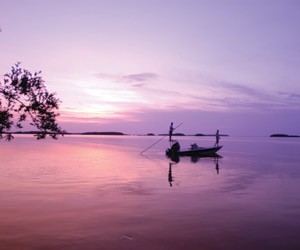Positioned between the Atlantic Ocean and the Gulf of Mexico at a latitude just beyond the tropics, Florida already enjoys balmy weather year-round and over a thousand sandy miles of coastline.
But the state’s lucky geography doesn’t end there. Scores of islands follow the shoreline around the peninsula—some a bridge away from the mainland, others more remote, but all adding another buffer zone between you and the daily grind.
"All of Florida’s islands enjoy a certain magical quality created by warm, salty breezes, sandy beaches and water of every imaginable shade of blue and green," says Gil Langley, president and CEO of the Amelia Island CVB. "It’s a welcome sense of separation from everyday life, even if only by the width of a river or bay."
Island Seclusion
Northeast of Jacksonville, Amelia Island is separated from the mainland by the Amelia River, which is part of the Intracoastal Waterway that loops around the entire state, creating many of the barrier islands that are famed for their beaches. Amelia definitely has the beaches, composed of natural quartz sand, but the island is also home to historical treasures like the Victorian port town of Fernandina Beach, as well as a number of beachside hotels and resorts, including the Omni Amelia Island Plantation Resort, Summer Beach Resort and The Ritz-Carlton, Amelia Island.
Amelia Island is also noteworthy for being one of the few places in the state that allows horseback riding on the beach; Hutchinson Island, farther down the Atlantic Coast, is another. Local outfitters in both locations can help your group saddle up.
Much farther down the Atlantic Coast, offshore from downtown Miami, is the isle of Key Biscayne, which packs quite a bit into its modest dimensions, including an oceanview golf course, two huge parks, a number of hotels, including The Ritz-Carlton, Key Biscayne, and the Tennis Center at Crandon, home of the annual Sony Ericsson Open.
Staying and playing "on island" is also part of the whole Gulf Coast experience, beginning at the Beaches of South Walton in Northwest Florida, where Choctawhatchee Bay separates the coastal communities of Seascape, Miramar Beach, Sandestin, Santa Rosa Beach, Dune Allen and others from the mainland. These Old Florida-style towns are pastel pretty and slow-paced, with easygoing resorts like Sandestin Golf and Beach Resort and the Hilton Sandestin Beach Golf Resort & Spa to match.
Meanwhile, one of Northwest Florida’s largest convention venues is also set on an island—the Emerald Coast Convention Center on Okaloosa Island, offering 35,000 square feet of meeting space and, need it be said, spectacular views.
To the east, the Bay Point Marriott Golf Resort & Spa in Panama City Beach runs group shuttles to nearby Shell Island for dolphin watching, team-building activities or lazy hours on the sand.
"It gets you into that undeveloped, natural, almost wild beach experience," says Dan Rowe, president and CEO of the Panama City Beach CVB. "In our daily lives, we’re surrounded by so many things, and things to do. To be able to go out to a barrier island and just experience the peace and quiet—it’s such a de-stressor."
Island Resorts
Heading south along the Gulf Coast, award-winning beaches fringe the western edges of barrier islands created by the Intracoastal Waterway off the coast of St. Petersburg/Clearwater, with resorts like TradeWinds Island Grand Resort and the Hyatt Regency Clearwater Beach Resort and Spa presiding over the sands.
Farther south, groups get that sense of seclusion—with civilization nearby—at the Longboat Key Club & Resort, with 218 rooms and meeting space for up to 150. Also serving meetings is the Hilton Longboat Key Beachfront Resort, where the Antigua meeting room overlooks the Gulf.
Cross the Longboat Pass Bridge to Anna Maria Island and you’ll enter a breezy world of fishing piers and waterfront restaurants, cozy beachside cottages and inns, and the free Anna Maria Island Trolley that gets you there effortlessly.
But in Cape Haze you’ll need a car ferry ride across the Intracoastal to reach Palm Island, home of Palm Island Resort, where the only means of transportation are golf carts, bicycles and your own two feet.
Off the coast of Fort Myers, Sanibel and Captiva islands—and their famed resorts—are well-known retreats, but there are actually more than 100 islands in Lee County. One is Useppa Island, whose history goes back to the Calusa Indians, Spanish Conquistadors and, closer to the modern era, advertising entrepreneur Barron Collier, who converted a friend’s mansion into an inn, welcoming such prestigious guests as Herbert Hoover, Gloria Swanson and Shirley Temple. The Collier Inn is still going strong today.
Useppa is accessible only by boat, and so is nearby Cabbage Key, a 100-acre island built atop an ancient Calusa Indian shell mound. Mystery writer Mary Roberts Rinehart helped her son build his home here in 1938, and today that house is a cozy inn with six guest rooms and a picturesque dining room papered in thousands of autographed dollar bills.
Reminiscent of old-time Florida, Cabbage Key is supposed to be the place that inspired Jimmy Buffett to pen his hit song, Cheeseburger in Paradise.
Island-Hopping
Not just an island, but an island chain is waiting in the Florida Keys, which extend off the Florida mainland to the southwest for 106 miles from Key Largo, south of Miami, to Key West, 90 miles north of Cuba.
Water activities dominate here, from diving and snorkeling in John Pennekamp Coral Reef State Park, the nation’s first underwater preserve, to fishing the waters off Islamorada and kayaking the placid backcountry waters of the Middle Keys and Lower Keys.
For landlubbers, there are plenty of parks and historic sites on terra firma, not to mention the many attractions of Key West, including the Ernest Hemingway Home and Museum, the Key West Tropical Forest & Botanical Garden, featuring a butterfly habitat and formal gardens, and the Mel Fisher Maritime Museum, housing priceless treasures from a 17th-century shipwreck. And though terra might not feel so firma afterward, many visitors end the night in Key West by doing the "Duval Crawl," pub-hopping along Duval Street, the island’s main drag.
Many hotels and resorts on Key West overlook the water, including Ocean Key Resort & Spa, but for that real "island" feel, try Hawk’s Cay on Duck Key, a sprawling resort with plenty of meeting space, or Little Palm Island Resort & Spa on Little Torch Key, accessible only by motor yacht shuttle.
Island Sanctuaries
On the southwestern tip of Florida, Marco Island—with its resorts and restaurants—is the largest in a chain of islands and mangrove islets known as the Ten Thousand Islands, which comprise a 35,000-acre National Wildlife Refuge that protects important mangrove habitats and a rich diversity of native wildlife, including 190 species of birds.
In fact, if your group’s idea of an island escape has more to do with finding nature versus an oceanfront resort, you’ll want to head to a place like Caladesi Island State Park, where hiking and kayaking trails take visitors around one of the few completely natural islands along Florida’s Gulf Coast.
"It’s a really nice experience; there’s a ton of wildlife out there," notes D.T. Minich, executive director of Visit St. Petersburg/Clearwater. "You get there by ferry from Honeymoon Island."
South of Caladesi Island and bookending the beaches of St. Petersburg/Clearwater is Fort De Soto Park, with a beach that was ranked No. 1 in the country by coastal geologist Dr. Stephen Leatherman, "Dr. Beach," in 2005. (Caladesi Island reached the top spot in 2008.) Made up of five interconnected islands, Fort De Soto includes nature and canoe trails, as well as the historic fort itself, built in 1898.
Other island-based nature retreats along the Gulf include the 403-acre Anclote Key Preserve State Park, located three miles off the coast of Tarpon Springs and home to 43 bird species, including the American oystercatcher and the bald eagle, and Cedar Keys National Wildlife Refuge, a group of fragile coastal islands—ranging in size from one to 120 acres—just off the village of Cedar Key, west of Ocala. Ferry and boat service is available to both locations.
Near the "big bend" region of Florida’s Gulf Coast, 2,023-acre St. George Island State Park is set between Apalachicola Bay and the Gulf of Mexico in Northwest Florida, providing a home base for shorebirds to nest along the sand and on the grass flats.
On the east coast, Pelican Island National Wildlife Refuge near Sebastian provides nesting habitats for the endangered wood stork and other birds, and is a designated site on the Great Florida Birding Trail.
Meanwhile, of the 10 National Seashores in the U.S., two are in Florida and one is the nation’s largest: Gulf Islands National Seashore near Pensacola. It encompasses submerged lands teeming with marine life, above-ground marshes supporting plants and animals and live oak forests that are home to resident and migrating bird populations.
"There is no development here, just miles of beautiful sand dunes with Pensacola Bay on one side and the Gulf of Mexico on the other," says Laura Lee, director of communications for the Pensacola Bay Area CVB. "It definitely feels like having an island to yourself. One of our properties, Portofino Island, actually borders the seashore. Guests can kayak and ride bikes along the seashore from the property."
Visitors might see a blast into space from the other seashore—Canaveral National Seashore, a barrier island adjacent to the Kennedy Space Center and known as Florida’s longest undeveloped Atlantic beach. Following the end of the U.S. Space Shuttle Program this year, unmanned vehicle launches will continue. Canoeing, surfing, fishing and hiking historical trails are among the many activities here.






